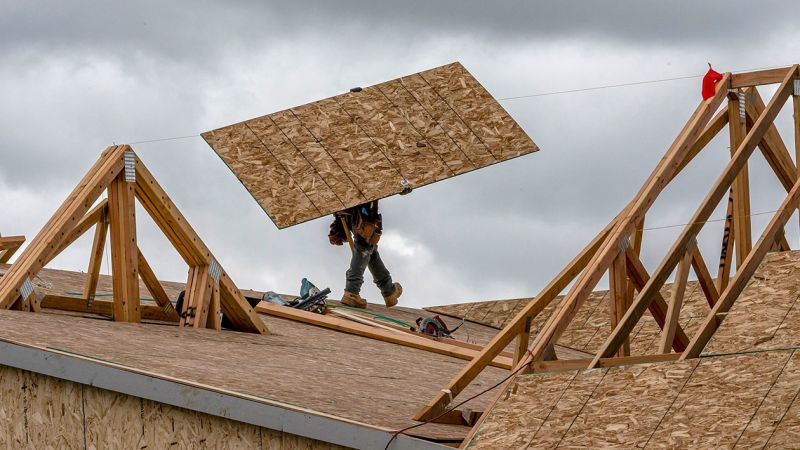When Washington sneezes, Canadian construction catches a cold. That’s becoming increasingly evident as the latest round of US tariffs on Canadian lumber and steel begin rippling through our housing market—with potentially dire consequences for homebuyers already struggling with affordability.
Walking through a half-finished development in Mississauga last week, veteran builder Sam Patel pointed to stacks of lumber and metal framing. “See those materials? They’re about 22% more expensive than this time last year,” he explained. “We’re absorbing some costs, but eventually, they’ll show up in home prices.”
The numbers paint a concerning picture. According to Statistics Canada, construction material costs have jumped 17% in the first half of 2025, with analysts at RBC Capital Markets projecting another 14-18% increase by 2027 if the current tariff structure remains unchanged.
The Canada-US trade relationship has always experienced turbulence, but the latest 27% tariff on softwood lumber and new 18% duty on fabricated structural steel represent what Canadian Manufacturers & Exporters President Dennis Darby calls “unprecedented pressure on our construction supply chain.”
For context, Canada supplies approximately 84% of all softwood lumber imports to the United States, according to Natural Resources Canada. When American demand slows or tariffs increase, that lumber gets redirected to the domestic market—but not necessarily at lower prices.
“It’s counterintuitive,” explains University of Toronto economist Patricia Cheng. “Even with more supply staying in Canada, prices rise because our producers must make up for lost American market access and increased compliance costs. The homebuilder ultimately pays more, not less.”
Those costs inevitably transfer to consumers. Canada Mortgage and Housing Corporation (CMHC) estimates that for every 10% increase in building material costs, the price of a new home rises by roughly 4.3%. With current projections, that translates to approximately $38,000 in added costs on an average new Canadian home by 2027.
For first-time buyers like Toronto tech worker Jamie Kowalski, these increases create another barrier to ownership. “We’ve been saving for five years, and the goalpost keeps moving,” Kowalski said while touring model homes in Etobicoke. “Every month we wait, prices climb higher.”
The effects extend beyond new construction. Renovation costs have also surged, with contractors reporting 30-40% price increases for basic home improvement projects. Mike Sullivan, who runs a renovation business in Halifax, says clients are scaling back projects or postponing them entirely. “People who planned full kitchen renovations are now just replacing countertops. The ripple effect hurts suppliers, tradespeople—everyone.”
Canadian policymakers find themselves in a difficult position. The federal government has filed complaints through CUSMA (the successor to NAFTA) dispute resolution mechanisms, but these processes typically take 12-18 months to resolve.
“We’re exploring targeted relief for builders and consumers,” said Deputy Prime Minister Chrystia Freeland during a press conference in Ottawa. “But the reality is that integrated supply chains can’t be quickly disentangled without significant economic disruption.”
Some companies are adapting through innovation. Vancouver-based Nexii Building Solutions has developed alternative construction materials that bypass traditional lumber and steel supply chains. “We’re seeing unprecedented interest in our plant-based building systems,” says CEO Gregor Robertson. “When traditional materials become unreliable or expensive, the market naturally seeks alternatives.”
Industry experts suggest several potential outcomes. Kevin Lee, CEO of the Canadian Home Builders’ Association, believes we may see a fundamental shift in construction approaches. “Mass timber, prefabrication, and modular construction could all gain traction as builders seek cost predictability. This trade dispute might inadvertently accelerate innovation.”
The situation highlights the vulnerability of Canada’s housing market to international trade policies. While Bank of Canada interest rate decisions receive extensive coverage, trade disputes often fly under the radar until their effects materialize in consumer prices.
For urban planners, the tariff situation complicates efforts to increase housing supply. “Municipalities across Canada have been streamlining approvals and updating zoning to enable more construction,” notes Jennifer Barrett, an urban planner with the City of Edmonton. “But if material costs make projects financially unfeasible, regulatory improvements alone won’t solve our housing shortage.”
The timing couldn’t be worse. Canada needs approximately 3.5 million new housing units by 2030 to restore affordability, according to CMHC research. If building costs continue rising at current rates, that target becomes increasingly difficult to achieve.
Some economists see a silver lining in potential innovation. “Throughout history, trade restrictions have sometimes sparked domestic industry development,” suggests Trevor Wilson, chief economist at Desjardins. “We may see increased investment in Canadian manufacturing capacity for construction materials, which could improve resilience over the long term.”
For prospective homebuyers, however, the immediate outlook remains challenging. Real estate boards across major Canadian cities report continued price increases despite higher interest rates, with supply constraints cited as a primary factor.
As Sam Patel wrapped up his tour of the Mississauga development, he offered a pragmatic assessment: “Construction has always faced challenges—weather, labor shortages, regulation. We adapt. But when these tariffs combine with existing pressures, something has to give. Either we build smaller homes, use different materials, or prices continue climbing.”
For Canadians hoping for housing affordability, the lesson is clear: solutions must address not only domestic policies but also the complex international trade relationships that directly impact the cost of putting roofs over our heads.






